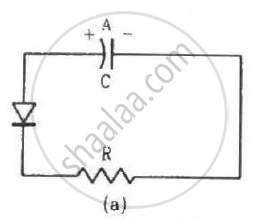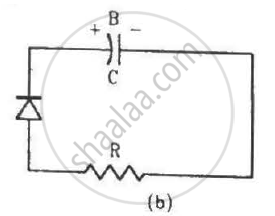Advertisements
Advertisements
प्रश्न
The conductivity of an intrinsic semiconductor depends on temperature as σ = σ0e−ΔE/2kT, where σ0 is a constant. Find the temperature at which the conductivity of an intrinsic germanium semiconductor will be double of its value at T = 300 K. Assume that the gap for germanium is 0.650 eV and remains constant as the temperature is increased.
(Use Planck constant h = 4.14 × 10-15 eV-s, Boltzmann constant k = 8·62 × 10-5 eV/K.)
उत्तर
Let the conductivity at temperature T1 be \[\sigma_1\] and the conductivity at temperature T be \[\sigma_2\] .
Given: \[T_1 = 300 K\]
Band gap, E = 0.650 eV
Now,
According to the question,
\[\sigma = \sigma_0 e -^\frac{\Delta E}{2KT}\]
\[\sigma_2 = 2 \sigma_1\]
\[\Rightarrow \sigma_0 e^\frac{- \Delta E}{2kT} = 2 \times \sigma_0 e^\frac{- \Delta E}{2 \times k \times T_1} \]
\[ \Rightarrow \sigma_0 e^\frac{- \Delta E}{2kT} = 2 \times \sigma_0 e^\frac{- \Delta E}{2 \times k \times 300} \]
\[ \Rightarrow e^\frac{- 0 . 650}{2 \times 8 . 62 \times {10}^{- 5} \times T} = 2 \times e^\frac{- 0 . 650}{2 \times 8 . 62 \times {10}^{- 5} \times 300} \]
\[ \Rightarrow e^\frac{- 0 . 650}{2 \times 8 . 62 \times {10}^{- 5} \times T} = 6 . 96561 \times {10}^{- 6} \]
On taking natural natural log on both sides, we get
\[\frac{- 0 . 650}{2 \times 8 . 62 \times {10}^{- 5} \times T} = - 11 . 874525\]
\[ \Rightarrow \frac{1}{T} = \frac{11 . 874525 \times 2 \times 8 . 62 \times {10}^{- 5}}{0 . 65}\]
\[ \Rightarrow T = 317 . 51178 \approx 318\] K
APPEARS IN
संबंधित प्रश्न
Distinguish between a conductor and a semi conductor on the basis of energy band diagram
Distinguish between a metal and an insulator on the basis of energy band diagrams ?
Distinguish between a conductor, a semiconductor and an insulator on the basis of energy band diagrams.
There are energy bands in a solid. Do we have really continuous energy variation in a band ro do we have very closely spaced but still discrete energy levels?
In semiconductors, thermal collisions are responsible for taking a valence electron to the conduction band. Why does the number of conduction electrons not go on increasing with time as thermal collisions continuously take place?
Let np and ne be the number of holes and conduction electrons in an intrinsic semiconductor.
A p-type semiconductor is
Two identical capacitors A and B are charged to the same potential V and are connected in two circuits at t = 0 as shown in figure. The charges on the capacitors at a time t = CRare, respectively,


In a transistor,
In a semiconductor,
(a) there are no free electrons at 0 K
(b) there are no free electrons at any temperature
(c) the number of free electrons increases with temperature
(d) the number of free electrons is less than that in a conductor.
In a pure semiconductor, the number of conduction election 6 × 1019 per cubic metre. How many holes are there in a sample of size 1 cm × 1 mm?
Suppose the energy liberated in the recombination of a hole-electron pair is converted into electromagnetic radiation. If the maximum wavelength emitted is 820 nm, what is the band gap?
(Use Planck constant h = 4.14 × 10-15 eV-s, Boltzmann constant k = 8·62 × 10-5 eV/K.)
What is forbidden band?
In a common-base circuit calculate the change in the base current if that in the emitter current is αmA and a = 0.98
The valance of an impurity added to germanium crystal in order to convert it into p-type semiconductor is
Hole are majority charge carrier in
Draw the energy band diagrams for conductors, semiconductors and insulators. Which band determines the electrical conductivity of a solid? How is the electrical conductivity of a semiconductor affected with rise in its temperature? Explain.
The energy required by an electron to jump the forbidden band in silicon at room temperature is about ______.
Which one of the following elements will require the highest energy to take out an electron from them?
Pb, Ge, C and Si
With reference to semiconductor physics, answer the following question.
In which material “Forbidden band” is absent?
